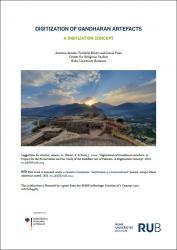Digitization of Gandharan Artefacts: A Digitization Concept
Keywords:
Digital Humanities, Gandhara, Buddhism, digitization, data management, Open DataSynopsis
The DiGA project digitizes and catalogues of a corpus of 1,791 Buddhist sculptures from the ancient region of Gandhara (present-day eastern Afghanistan/north-western Pakistan). These originate from 13 Buddhist sites in the modern districts of Lower Dir and Swat in the Province of Khyber-Pakhtunkhwa and are currently kept in the Dir Museum in Chakdara and in the Mission House of the Missione Archeologica Italiana in Pakistan in Saidu Sharif. These collections provide a solid corpus for reassessing the history of Buddhism and Buddhist art in the region because their archaeological provenance is known. DiGA will result in a database that will be accessible on heidICON, the multi-media platform of Heidelberg University Library. This publication presents the digitization concept which underpins the DiGA project. It highlights the scientific relevance of the collections, describes the data management plan implemented for the photographic documentation of the objects and the indexing of the related metadata. In this respect, it addresses Open Data strategies employed to ensure the interoperability of the database and its long-term accessibility.


